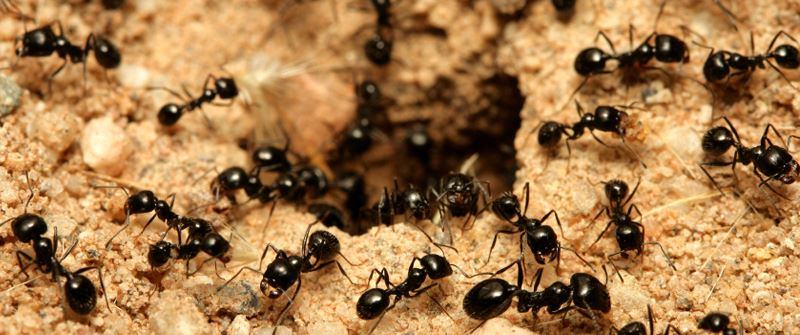
Three Types of Ants: Males, Females and Neuters. Life Cycle of Ants.
The constitution of an ant-community may be readily appreciated; but it is, at the same time, important to note the distinctions between the various groups or sects into which the curious colony is divided. A threefold distinction of sex, resulting in the production of three kinds of individual forms, is to be perceived in the ant-colony, as well as among other hymenopterous insects (e.g. bees).
These three grades of individuals are known respectively as males, females, and neuters. The males and females are winged, – the former retaining their wings throughout life, and the latter losing these organs after the pairing is over. During the summer the winged males and females are produced in large numbers, and they soon leave the nest to take their “nuptial flight” in the air, in the course of which the females are impregnated.
The function of the male ants having been thus performed, they die; the females, after impregnation, lose their wings; and whilst in this comparatively helpless state they are conveyed by the neuters to new situations, where they become the founders of fresh colonies.

Each fertile female or “queen” is carefully attended by a retinue of “neuters,” the latter being simply females the sexual organs of which are undeveloped. The curious experiments of entomologists have proved that, in all probability, the cause of this differentiation of sex is dependent upon the nature of the food with which during the larval state the ant is fed. Exempted thus from all sexual functions, the duties of the neuters are confined to the performance of all the offices which contribute to, or are connected with, the welfare and labour of the ant-community.
They thus not only construct and build the nest or home, and keep it in constant and assiduous repair, but they are also the providers of food and sustenance for the community; and they act the part of nurses, in that they carefully attend to the hatching, nutrition, and rearing of the young. They are also the defenders of the colony, in that they protect the nest and its inmates from the attacks and assaults of nearly-related enemies or foreign foes.
In connection with the defense of the ant-colony, certain species possess peculiar neuters, termed “soldiers,” upon which the care and protection of the community more especially devolve. These soldiers” are provided with large mandibles or biting-jaws, which constitute efficient organs of offence or defence; and they are distinguished from the ordinary neuters by several characteristics in addition to this larger development of the jaws.
Regarding the more intimate structural differences which have been ascertained to exist between the various members of the ant-community, it may be remarked that the antennae of the male ants possess thirteen joints each, and those of the female twelve. The antennae of the neuters are composed of twelve joints.
The abdomen of the male ant consists of seven joints, and that of the female and neuter of six. The mandibles or large jaws of the female and neuter ants are larger than those of the males, and are frequently found to be serrated or even hooked at their extremities. The external sexual organs of the neuters correspond to those of the females, although, as already remarked, the essential internal reproductive organs are wholly undeveloped in the neuter ants; and to this most important distinction there is added the absence of wings, the neuters being thus distinguished from the females by a variety of characters, while the near relation is at the same time shown of the one series of truly sexual forms to those in which the sex is undeveloped. The neuters, it may lastly be remarked, conform to the female characteristics, in having the abdomen provided with a sting, the make ants being destitute of this appendage.






























